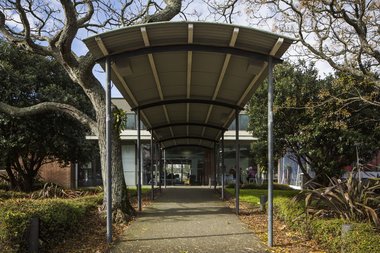John Hurrell – 17 July, 2015
In clement weather it was quite pleasant to move around between the four speakers - asymmetrically positioned to make you approach from unorthodox angles - to explore what each grey box emitted. There were no migraine-inducing scraping, scrunching, crushing, or grinding noises, only (still) industrial hums that didn't throb or screech, only gently meander, flutter, whistle and whir.
‘Rough music’ - Richard Francis‘ title - apparently is the term for driving somebody deemed ‘undesirable’ out of a village by getting a crowd to surround the cottage and cacophonously beat pots and pans - raucously carrying on until the ‘offender’ leaves. It’s a form of unsubtle but sonically effective, social excommunication.
Seeing this work was installed (via speakers in the sheltering iron roof) over the path that leads to the gallery entrance, it was a pretty droll concept. You drive people into the building, not out of it. The funny thing is that there was a logic. My memories of at least three Francis shows is that his aural textures used to be a lot more confrontational, more aurally abrasive, especially with his use of static-type textures. Assuming my recollection is accurate, this more recent work was more generally user-friendly - vaguely like a synthesis of Eno and Stockhausen; lots of layered rumbling drones and whines of different pitches that caused you to test out different sections of the path.
In clement weather it was quite pleasant to move around between the four speakers - asymmetrically positioned to make you approach from unorthodox angles - to explore what each grey box emitted. There were no migraine-inducing scraping, scrunching, crushing, or grinding noises, only (still) industrial hums that didn’t throb or screech, only gently meander, flutter and whirr.
You had to take time to listen to the layered combinations, to carefully determine the characteristics of each intermittently sounding source. The silences were unpredictable, and aspects of this show were similar to the work Ryoji Ikeda had in the silos on the waterfront over the 2013 Triennial. The listener’s bodily position affected their aural sensations and the specific pitch qualities, even though the omnipresent Reeves Road traffic noise made it difficult to analyse.
Francis‘ lack of consternation over local ambient noise gave him affinities with sonic legend, the late Max Neuhaus, who deliberately positioned sound installations in the heart of busy cities, seeking (amongst pedestrians) a sophisticated audience with keen ears that could detect his unusual frequencies - often encountered at crowded intersections. Something similar was occurring here at the Te Tuhi entrance.
John Hurrell

 Advertising in this column
Advertising in this column Two Rooms presents a program of residencies and projects
Two Rooms presents a program of residencies and projects



This Discussion has 0 comments.
Comment
Participate
Register to Participate.
Sign in
Sign in to an existing account.